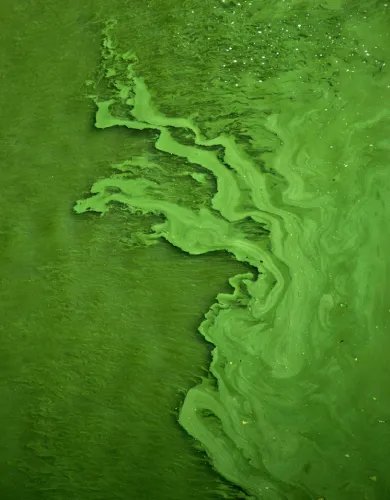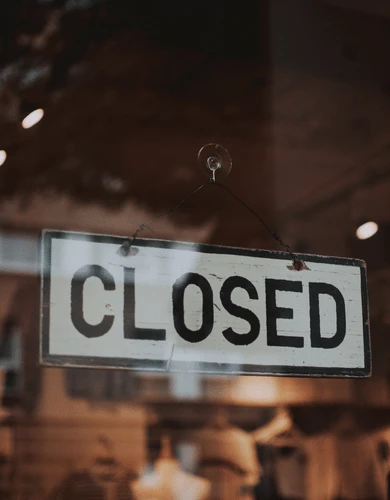The British water infrastructure
Homes and businesses across the UK enjoy one of the world’s safest water supplies. It’s not something that most people spend a lot of time thinking about, but a lot of work goes into operating the British water infrastructure.
British water infrastructure consists of over 400,000 miles of pipes connecting over 50 million properties. Maintaining and operating the network employs over a hundred thousand people.
This massive industry faces a challenge in maintaining its high-quality standards as global warming makes water ever more scarce.
This guide looks at what the water industry does and what companies are involved.
British potable water infrastructure
Let’s start by looking at the processes involved in supplying safe drinking water to properties.
Stage one – Collection of rainwater
In Britain, we are blessed with an abundance of rainwater. Some countries need to rely on the desalination of seawater for water supply. In Britain, all the water supplied to properties ultimately comes from rain.
Water companies collect rainwater either from:
- Rivers
- Streams
- Aquifers (underground sources of water)
Stage two – Storage
Rainwater is unreliable; in the summer months, the sources used by the water industry frequently run dry. To solve this problem, the water industry stores water in reservoirs.
Reservoirs are vast manmade lakes that store water before treatment. Here’s what a reservoir looks like:
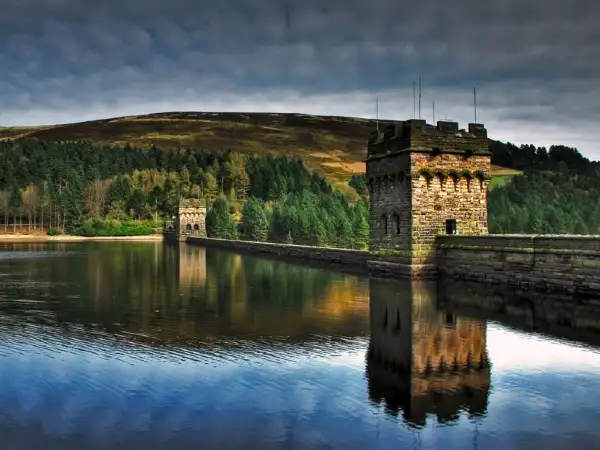
Stage three – Treatment
To make the water safe to drink, a treatment centre sanitises the water before it moves into the pipe network. Water treatment is a multi-stage process involving:
- Screening – Removing large debris like twigs and leaves
- Flocculation – Adding a coagulant to the water to bond together contaminants, making them easier to remove.
- Filtering – Filtering the water through the sand to remove impurities.
- Chlorine – Adding a small amount of chlorine to kill off any bacteria.
Water treatment centres are quality controlled by continuous testing of the quality of water they produce.
Stage four – Transportation
Treated water is temporarily stored in covered tanks before being pumped through a network of pipes. The mains water network follows the road network to reach homes and businesses.
Properties are connected to the mains network via communication pipes. The water companies are responsible for all pipes up to the boundary of private properties, where there is usually a stopcock valve and a water meter.
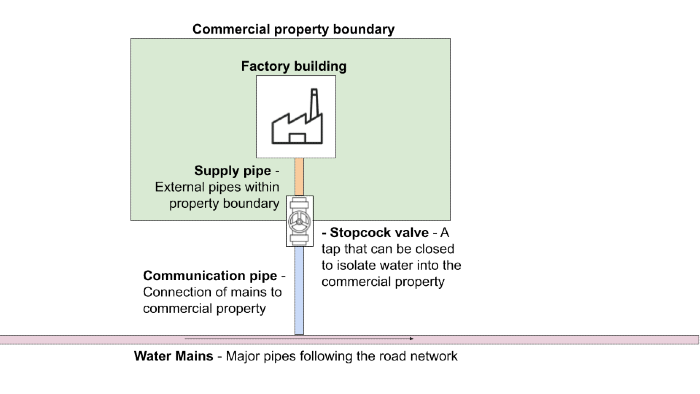
Wastewater infrastructure
Most water supplied to properties gets returned after usage. Water flushed down the toilet, drained into sinks or showers, and used by washing machines and dishwashers all goes into the drains. This water is generally known as wastewater.
The water industry is responsible for safely treating wastewater before draining it into rivers or the sea. See more in our full article on the environmental impacts of the water industry.
Step one – Transportation
The wastewater drains into large sewer pipes that follow the road network. Wastewater companies use a series of pumps to move the wastewater to sewage treatment works.
Step two – Wastewater treatment
Wastewater contains lots of nasty human waste and other contaminants that are removed at a wastewater treatment centre.
The wastewater treatment process involves:
- Settlement – Wastewater is stored in large settlement tanks where solids (known as sludge) sink to the bottom. The sludge separates from the water for further treatment.
- Aeration – Air is pumped into the wastewater to encourage bacteria to break down any organic material present in the wastewater.
- Filtration – Wastewater is filtered through a layer of sand to catch any remaining particles of sludge.
As a side, the water industry is starting to use sludge as a free source of green energy. Anaerobic digesters use bacteria to convert the sludge into renewable biogas.
Step three – Returning the water to the rivers
Treated wastewater is returned to the rivers as a replacement for the water taken out back in step one of the water infrastructure.
It’s worth noting that a recent investigation has found water companies regularly dumping untreated wastewater in rivers. Ofwat, the regulator, is continuing to investigate the responsible wastewater companies.
Rainwater drainage infrastructure
An essential but often overlooked role of wastewater companies is managing rainwater drainage from urban areas.
Urban areas replace naturally draining land with concentrate and tarmac, which do not drain. Drainage infrastructure creates an artificial way of safely channelling rainwater out of urban areas. Without drains, urban areas would flood every time there was a rain shower.
Unlike wastewater, rainwater is safe for the natural environment. The rainwater and drainage systems move the water away from urban areas and safely into local streams and rivers.
British water companies
As you’ve seen above, managing water, rainwater, and wastewater requires a lot of infrastructure.
Given that all British properties require these services, it makes sense that one organisation manages this whole system, right? Unfortunately, the situation is a little more complicated.
The water industry developed piece by piece. Until the 1950s, the country consisted of a patchwork of over a thousand different water utilities, each independently managing its own area.
Gradually, this consolidated into something more sensible, into what we have today, where the country is split into 12 water and wastewater companies and six water-only companies.
In Scotland, it’s simple, Scottish Water manages both the water and wastewater network. In England and Wales, the country is divided into the following areas:
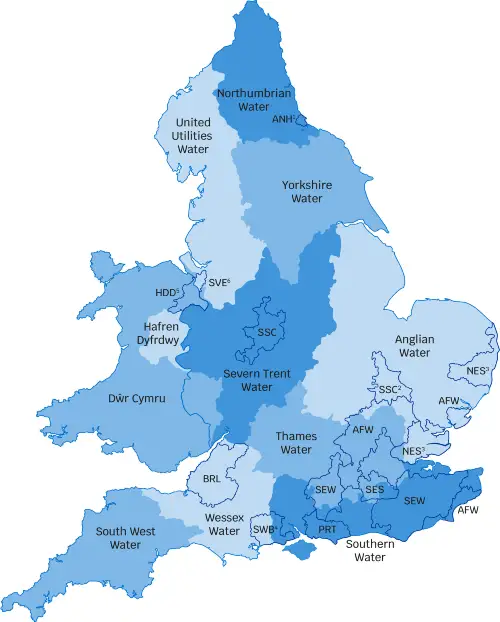
To help navigate this confusing situation, here’s a postcode lookup to help you discover the water and wastewater service provider for your property. Alternatively, we provide service to find out who your business water supplier is.
Here are the details of each of the local water and wastewater companies:
Anglian Water
Anglian Water provides water and wastewater services in the East of England, encompassing an area of seven million people.
Confusingly Anglian Water manages water services in Hartlepool, a small town North of Middlesborough, which is not at all connected to the rest of Anglian Water’s network.
Website: https://www.anglianwater.co.uk/
Affinity Water
Affinity Water is a water-only provider. Affinity Water is the consolidation of a few different water companies, so they manage several separate areas, as follows:
- An area to the North East of London covering bits of Bedfordshire, Berkshire, Buckinghamshire and Hertfordshire.
- The tendering peninsula in Essex
- Folkestone and Dover in Kent.
Website: https://www.affinitywater.co.uk/
Bristol Water
Bristol water provides water services to half a million homes in an area that includes Bristol and Bath, bits of Somerset and South Gloucester. Wessex Water is responsible for wastewater services to all of Bristol Water’s customers.
Website: https://www.bristolwater.co.uk/
Welsh Water
The Welsh Water infrastructure works differently from the rest of the country. Welsh Water is a not-for-profit organisation that works for the benefit of the Welsh people rather than for private shareholders.
Welsh Water serves most of Wales and some bits of Herefordshire and Deeside on the other side of the English border.
Website: https://corporate.dwrcymru.com/en
Hafren Dyfrdwy (Severn Dee)
Hafren Dyfrdwy is a water service provider for customers in a small Welsh region near the English border that covers Wrexham and Welshpool.
Harden Dydrdwy is part of the Severn Trent group.
Website: https://www.hdcymru.co.uk
Northumbria Water
Northumbria Water manages the water and wastewater infrastructure in the North East of England, serving three million customers.
Confusingly Northumbria Water also manages a small water-only network in Suffolk and Essex.
Website: https://www.nwg.co.uk/
Portsmouth Water
Portsmouth is one of two cities on the South Coast of England that, for some reason, has separate water infrastructure.
Portsmouth Water provides water-only services to a small area surrounding Portsmouth from the river Meon in the West to the River Arun in the East.
Website: https://www.portsmouthwater.co.uk/
Bournemouth Water
Bournemouth, a neighbouring city to Portsmouth on the South Coast, also has separate water infrastructure.
Bournemouth Water provides water-only services to the city of Bournemouth and a small area to the North and East, which includes the New Forest.
Website: https://www.bournemouthwater.co.uk/
Severn Trent Water
Severn Trent supplies water and wastewater services to the area that broadly covers the Severn and Trent river basins.
Website: https://www.stwater.co.uk/
South East Water
South East Water provides water services to over 2 million people in the South East of England.
Confusingly South East Water’s infrastructure comprises two separate areas, one surrounding Basingstoke in Hampshire and another in Kent and Sussex. Both these areas sit within the Southern Water wastewater area.
Website: https://www.southeastwater.co.uk/
Southern Water
Southern Water provides wastewater services to the counties south of London and the Isle of Wight. Five separate water-only companies manage their water infrastructure within the Southern Water sewerage area.
Website: https://www.southernwater.co.uk/
South Staff Water
South Staff Water provides water-only services in an area that encompasses parts of the West Midlands, South Staffordshire, South Derbyshire and North Warwickshire.
South Staff Water also operates another water-only network in Cambridge, called Cambridge Water.
Websites:
https://www.south-staffs-water.co.uk/
https://www.cambridge-water.co.uk
South West Water
South West Water provides water and wastewater services in a large area covering all of Cornwall and Devon and parts of both Somerset and Dorset.
Website: https://www.southwestwater.co.uk
SES Water
SES water provides water-only services to a small area south of London, covering Sutton and East Surrey (hence the name).
Website: https://seswater.co.uk/
Thames Water
Thames Water operates the most extensive water infrastructure network (at least by population served). Thames Water provides water and wastewater services in an area that broadly encompasses the Thames basin and includes London.
Website: https://www.thameswater.co.uk/
For more information, here’s our guide to Thames Water Business.
United Utilities
United Utilities operates water and wastewater infrastructure in the North West of England. The area includes the population centres of Manchester and Liverpool and the Lake District.
Website: https://www.unitedutilities.com/
Wessex Water
The Wessex Water infrastructure provides water and wastewater services in the South West of England in an area East of Devon between the Bristol Channel and the English Channel.
Wessex Water provides sewerage services in the Bristol Water and Bournemouth Water areas.
Website: https://www.wessexwater.co.uk/
Yorkshire Water
Yorkshire Water (as you may have guessed) covers the water infrastructure in the county of Yorkshire. Yorkshire Water provides both water and wastewater services in the region.
Website: https://www.yorkshirewater.com
Scottish Water
The Scottish Water Industry operates entirely separately from the English one. Scotland pursued deregulation of the business water sector before the rest of the country.
Instead of having a patchwork of separate bits of water infrastructure, Scotland has a single responsible company called Scottish Water.
Website: https://www.scottishwater.co.uk/
Local independent water companies
The water industry also includes tiny water and wastewater networks managed by private companies. These typically occur when a developer chooses to construct water, electricity, and gas infrastructure privately rather than rely on local utilities.
These private companies have the same powers and responsibilities as any other water company in England and Wales, just for particular areas. Here’s a list of the local water companies operating in Britain.
Albion Water
Supplier of water infrastructure to:
- Ebbsfleet Garden City, Kent
- Knowle Village, Hampshire
- Upper Rissington, Gloucester
- Oaklands Hamlet, Essex
Website: https://www.albionwater.co.uk
Albion Eco Limited
Albion is the supplier of water and wastewater services to an industrial area in Shotton, Wales.
Website: https://www.albioneco.co.uk/
County Water Limited
Supplier of Wastewater services new build development in Heyford Park, Oxfordshire
Website: https://www.countywater.co.uk/
Icosa Water Services Limited
Icosa is the supplier to various new-build developments across the country.
Website: https://www.icosawater.co.uk
Independent Water Networks
Independent Water is the supplier to various new-build developments across the country.
Website: https://www.iwnl.co.uk/
Leep Networks (Water) Ltd
Leep operates multi-utility networks in newly built industrial areas like MediaCity Manchester, Liverpool Waters and Canary Wharf.
Website: https://www.leeputilities.co.uk
Severn Trent Services (Water and Sewerage) Ltd
Confusingly Severn Trent, which already has its wholesale area, operates the water network in Aurum Green, Basingstoke, within the South East Water supply area.
Website: https://www.stservices.co.uk
Veolia Water Projects Ltd
Veolia Water Projects provide water and sewerage services to domestic and commercial customers in Wiltshire’s Tidworth and Perham Down area.
Website: https://www.veolia.co.uk/services/water-services-tidworth
